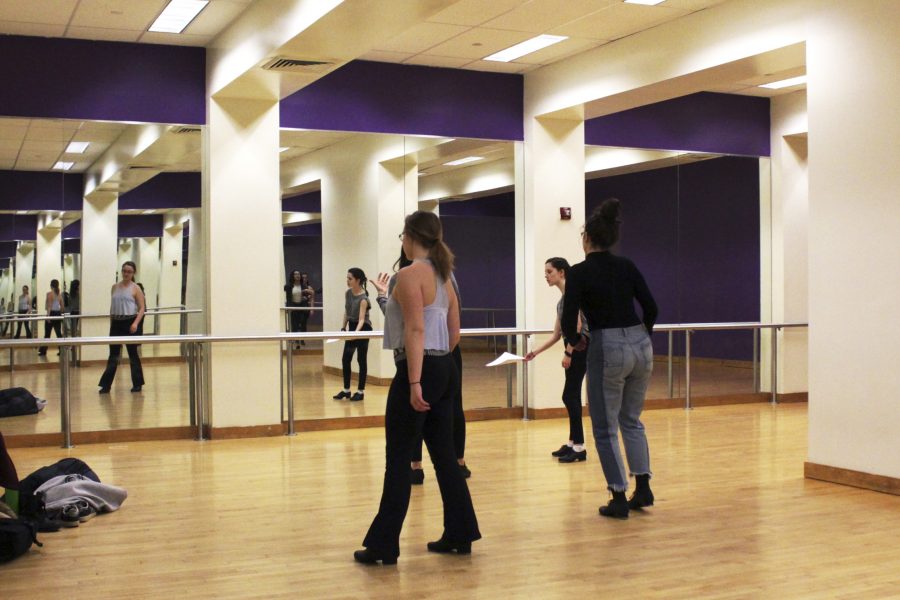Tisch Grads Collab for Evocative Dance
This past weekend’s Tisch Dance MFA 1 Concert, a program of original works both choreographed and performed by students, introduces many artistics and political themes, such as gender roles and domestic abuse. The first-year graduate MFA 1 students spent a semester choreographing the works.
February 27, 2017
Gender roles, domestic abuse and even dance itself came under the microscope this past weekend at the Tisch Dance MFA 1 Concert, a program of original works choreographed and danced by students. Exploring a myriad of themes in the artistic and political spectrums, the first-year graduate MFA 1 students spent a semester choreographing works for talented undergraduates to perform.
Couple dances were the focus of the evening — nearly half of the pieces involved only two dancers. Colleen Barnes’ “Balletic Movement Study #451” was a standout, both artistically and critically. The evening’s sole ballet piece featured sophomore Maxfield Haynes and freshman Maia Kaimakliotis wearing pointe shoes and watercolor tulle skirts. The choreography allowed Haynes to represent both the athleticism and vulnerability of male dancers, demonstrating a concerted effort by the collaborators to deconstruct gender roles in ballet.
Haynes spoke about the piece’s development and inspiration.
“The inception for the piece came from Colleen observing my pointe work in class,” Haynes said. “Inspired, Ms. Barnes created a piece that featured both a woman and man en pointe. Since Tisch is more contemporary, ballet is not often seen on our stage. She wanted to showcase the technical side of Tisch dancers that is very much so there, but not always present in the work.”
Another notable duet was choreographer Djassi Da Costa Johnson’s “Il vuoto, Il volo,” which is Italian for “the space, the soar.” The piece took advantage of the stage’s barren and expansive space to showcase its dancers’ abilities to soar with jumps and lifts. Haynes and freshman Annalise Van Even, garbed in nude costumes, had great chemistry on stage. At the beginning of the piece, Van Even danced as if she were running away from an unknown pursuer. Later, it became apparent that she was searching for Haynes, whom Johnson described as a “guardian angel” or “safety net” in the program notes. Haynes reflected this description when he supported Van Even as she extended her body into a midair split.
Perhaps the most unconventional piece of the evening was “Dice.” Featuring alumni Norberto Collazo and Abraham Texidor in exaggerated goggles and earth-tone tights, “Dice” called for bug-like choreography, incorporating convulsive movements and intricate male-on-male partnering reminiscent of predators hunting prey.
As the evening progressed, the number of dancers onstage grew with pieces like the all-male “Tribal Prime” and the atmospheric “Derivative,” which featured a pulsing score and silhouetted dancers. “All Foam, No Content” translated the everyday routines of New Yorkers to the stage with movements evocative of rolling out of bed, getting dressed and a morning subway commute.
But the ensemble piece that rose above the rest was Valeria Gonzales’ powerful “all women in me are.” She focused her work on not just art, but also the role it can play in social awareness.
“The piece aims to speak up and bring an awareness that domestic violence is not only physical,” Gonzales said.
The dance began with an eerily lit, low-to-the-floor solo performed by the piece’s lead, sophomore Isadora Elmira, followed by a corps of women dressed in multicolored bobbed wigs. It was here where dance stood out, not only as a medium of art, but also as a message. Gonzales incorporated both choreographed sequences and improvisation from the dancers, exploring the mental and physical pain of domestic abuse. Gonzales said she hopes “all women in me are” empowers and inspires everyone, especially the women who see it.
The showcase left viewers both awed and confident that dance was more than mere entertainment, if it has ever been that — it is a medium of communication and expression more intimate than speech, and more visual than literature.
A version of this article appeared in the Monday, Feb. 27 print edition.
Email Ryan Mikel at [email protected].
























































































































































